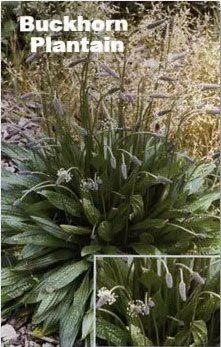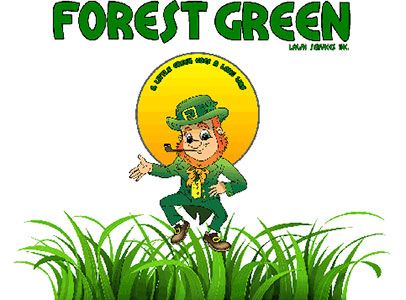
Professional Weed Control Services
Count on Forest Green Lawn Services to provide you with effective solutions to protect your lawn from harmful weeds. The certified and licensed team at Forest Green Lawn Services has over 40 years of experience and will first carry out a FREE analysis of your lawn. We'll implement appropriate weed control procedures to prevent the growth of weeds without affecting the health of the plants.
Trust us to use name-brand weed control and removal products on your lawn. Get in touch with us today for an appointment!
Weeds That Can Damage Your Lawn:
Trust us to use name-brand weed control and removal products on your lawn. Get in touch with us today for an appointment!
Weeds That Can Damage Your Lawn:
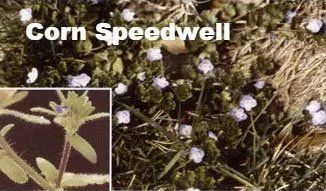
Corn speedwell
This weed grows as a single plant from a seed. It can be distinguished from other perennial species due to its seed. Its flowers look similar to the perennial ones. The winter annual species grows during the fall and flowers during the spring. It's difficult to control its growth. The set seeds are eliminated by hot and dry climate.
This weed grows as a single plant from a seed. It can be distinguished from other perennial species due to its seed. Its flowers look similar to the perennial ones. The winter annual species grows during the fall and flowers during the spring. It's difficult to control its growth. The set seeds are eliminated by hot and dry climate.
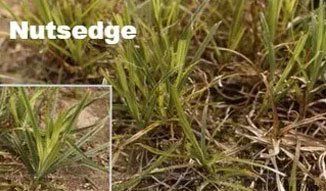
Nutsedge
It's a perennial species germinating from seeds of unmowed plants. It grows as narrow spikelets on the umbel-like inflorescence. It has triangular stems and leaves that are tree-ranked, narrow, and have grass-like bases. The yellow nutsedge has single, fleshy tubers on their roots, while the purple nutsedge has strings of tubers on wiry rhizomes.
It's a perennial species germinating from seeds of unmowed plants. It grows as narrow spikelets on the umbel-like inflorescence. It has triangular stems and leaves that are tree-ranked, narrow, and have grass-like bases. The yellow nutsedge has single, fleshy tubers on their roots, while the purple nutsedge has strings of tubers on wiry rhizomes.

Spurge
These are summer annual species which seeds when the soil temperature is around 55 degrees and continues to grow throughout the summers. The plant matures in hot climate conditions and it alone can produce several thousand seeds. There are small, oval opposite leaves that vary from dark green to red with brown blotches on the upper surface. The stem is reddish and low-grown and evolves from taproots forming a dense mat. The milky sap is sticky.
These are summer annual species which seeds when the soil temperature is around 55 degrees and continues to grow throughout the summers. The plant matures in hot climate conditions and it alone can produce several thousand seeds. There are small, oval opposite leaves that vary from dark green to red with brown blotches on the upper surface. The stem is reddish and low-grown and evolves from taproots forming a dense mat. The milky sap is sticky.
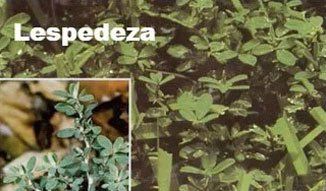
Lespedeza
An annual species that grows all summer and blooms during August through October. It has small flowers of purple color. The fruits are oval in shape. It's a prostrate and forms mats up to 18 inches in diameter.
An annual species that grows all summer and blooms during August through October. It has small flowers of purple color. The fruits are oval in shape. It's a prostrate and forms mats up to 18 inches in diameter.
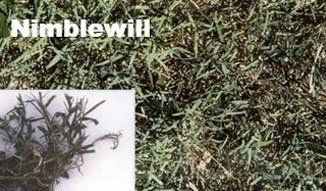
Nimblewill
It's a perennial reproduce from seeds. It's quite often mistaken for bentgrass in the North and bermudagrass in the South. It turns brown with the first frost.
It's a perennial reproduce from seeds. It's quite often mistaken for bentgrass in the North and bermudagrass in the South. It turns brown with the first frost.

Knotweed
This is characterized by a short stem and long taproot. It has large yellow flowers that mature into round puffballs full of seed. The leaves bear rosettes and are oblong, lobed, and narrow. It flowers in spring or the early summer.
This is characterized by a short stem and long taproot. It has large yellow flowers that mature into round puffballs full of seed. The leaves bear rosettes and are oblong, lobed, and narrow. It flowers in spring or the early summer.
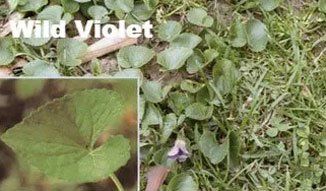
Wild Violet
It's 2 to 5 inches tall with heart-shaped leaves and small, pansy-like flowers, which are anything from blue-violet to lilac or white. It's a perennial bloom between March and May. It grows best in cooler temperature.
It's 2 to 5 inches tall with heart-shaped leaves and small, pansy-like flowers, which are anything from blue-violet to lilac or white. It's a perennial bloom between March and May. It grows best in cooler temperature.

Curly Dock
It's a perennial species blooming between April and July. It's most active when the turf is dry and heat-stressed. It has small, green flower clusters near the top of the tall, main stem. The rosette has lance-shaped leaves with puckered, wavy edges.
It's a perennial species blooming between April and July. It's most active when the turf is dry and heat-stressed. It has small, green flower clusters near the top of the tall, main stem. The rosette has lance-shaped leaves with puckered, wavy edges.
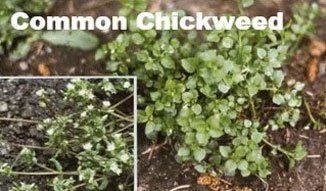
Common Chickweed
It's a winter annual bloom with low, slender, branched, and creeping stems with rows of hair. It has roots at its nodes. The leaves are yellow-green and heart-shaped with pointed tips. It grows best in cool and wet climates. It's differentiated from the mouse-ear chickweed by its shiny, light-green color.
It's a winter annual bloom with low, slender, branched, and creeping stems with rows of hair. It has roots at its nodes. The leaves are yellow-green and heart-shaped with pointed tips. It grows best in cool and wet climates. It's differentiated from the mouse-ear chickweed by its shiny, light-green color.
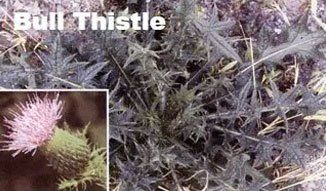
Bull Thistle
It's a biennial species that grows into a rosette of large, fleshy leaves with spines and toothed edges. It produces fewer flowers as compared to Canada thistle, which are fertile. In the second year, a woody stock produces a few rose-purple blossoms.
It's a biennial species that grows into a rosette of large, fleshy leaves with spines and toothed edges. It produces fewer flowers as compared to Canada thistle, which are fertile. In the second year, a woody stock produces a few rose-purple blossoms.
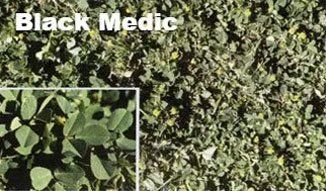
Black Medic
It's similar to clover, except for the unique extended center leaflet. It forms a mat in the dormant turf. It has clusters of bright yellow flowers that mature and turn into thick, black, coiled seed pods.
It's similar to clover, except for the unique extended center leaflet. It forms a mat in the dormant turf. It has clusters of bright yellow flowers that mature and turn into thick, black, coiled seed pods.
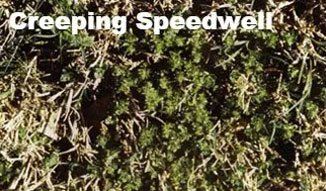
Creeping Speedwell
It's perennial with small, delicate flowers, which are blue, pink or white. The leaves are scalloped on margins and positioned on opposite branches. Its growth is difficult to control because it's a creeper. It roots itself in the soil where the stem touches.
It's perennial with small, delicate flowers, which are blue, pink or white. The leaves are scalloped on margins and positioned on opposite branches. Its growth is difficult to control because it's a creeper. It roots itself in the soil where the stem touches.
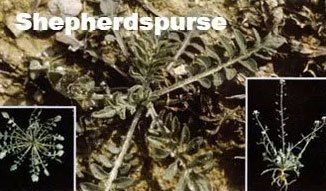
Shepherd's Purse
It's a winter annual belonging to the mustard family reproduced from seeds during the fall. It has a rosette growth with leaves that are hairy and have various lobes. There's a single, leafless stalk with small, white flowers, followed by a heart-shaped seed pod that contains shiny, orange-brown seeds.
It's a winter annual belonging to the mustard family reproduced from seeds during the fall. It has a rosette growth with leaves that are hairy and have various lobes. There's a single, leafless stalk with small, white flowers, followed by a heart-shaped seed pod that contains shiny, orange-brown seeds.
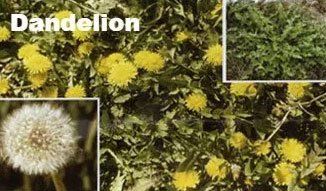
Dandelion
It's a seed reproduce. This has short stems and oblong, lobed, and narrow leaves that bear rosettes. The large yellow flowers mature into round puffballs full of seed, distributed by the wind for miles. It flowers during spring and the early summer and has long taproots.
It's a seed reproduce. This has short stems and oblong, lobed, and narrow leaves that bear rosettes. The large yellow flowers mature into round puffballs full of seed, distributed by the wind for miles. It flowers during spring and the early summer and has long taproots.
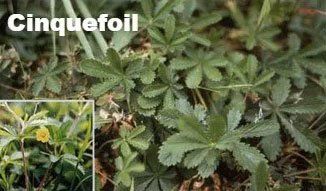
Cinquefoil
It's a perennial species growing in dry areas and resembles wild strawberry. It grows from seeds and runners. It has yellow flowers along the leaf axis. The leaves are palmately compounded with three leaflets and two lateral leaflets that are parted in a way to produce five leaflets that are arranged like fingers.
It's a perennial species growing in dry areas and resembles wild strawberry. It grows from seeds and runners. It has yellow flowers along the leaf axis. The leaves are palmately compounded with three leaflets and two lateral leaflets that are parted in a way to produce five leaflets that are arranged like fingers.
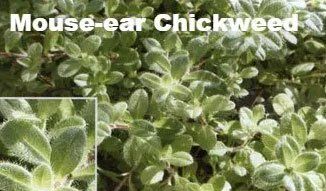
Mouse-Ear Chickweed
A vigorous perennial growth, it spreads with horizontal stems rooting at the nodes. It has oblong, stalkless leaves that have soft hair. The leaves are darker than those of the common chickweed. It can tolerate low mowing heights.
A vigorous perennial growth, it spreads with horizontal stems rooting at the nodes. It has oblong, stalkless leaves that have soft hair. The leaves are darker than those of the common chickweed. It can tolerate low mowing heights.
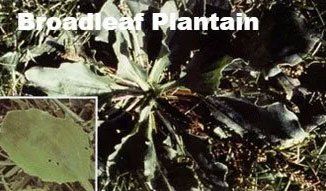
Broadleaf Plantain
It's a perennial rosette reproduced by seeds. The seed stem resembles a rat's tail and the stem supports small flowers and seeds. It has large, rounded, deeply-veined leaves with wavy edges and purple-colored petioles. It has long taproots which are similar to that of dandelions and helps in increasing the plant's resistance to stress and herbicides.
It's a perennial rosette reproduced by seeds. The seed stem resembles a rat's tail and the stem supports small flowers and seeds. It has large, rounded, deeply-veined leaves with wavy edges and purple-colored petioles. It has long taproots which are similar to that of dandelions and helps in increasing the plant's resistance to stress and herbicides.
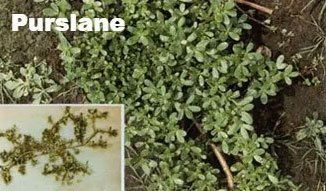
Purslane
It's a summer annual species that germinates in soil temperatures of 70 to 80 degrees. It forms a mat and has green, thick, fleshy, stemless leaves. The stem is succulent and reddish, originating from the taproot. The seeds mature within 2 weeks and survive for one week after flowering.
It's a summer annual species that germinates in soil temperatures of 70 to 80 degrees. It forms a mat and has green, thick, fleshy, stemless leaves. The stem is succulent and reddish, originating from the taproot. The seeds mature within 2 weeks and survive for one week after flowering.
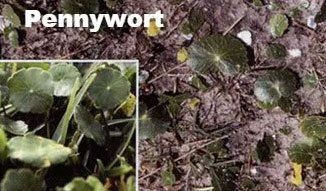
Pennywort
It's a perennial produce growing from rhizomes, tubers, and seeds. Mostly found in the transition zone and the south, this species generally grows in moist to wet soil. It has erect leaves with scalloped margins (inset) on long petioles in the centers of the umbrella-shaped leaves.
It's a perennial produce growing from rhizomes, tubers, and seeds. Mostly found in the transition zone and the south, this species generally grows in moist to wet soil. It has erect leaves with scalloped margins (inset) on long petioles in the centers of the umbrella-shaped leaves.
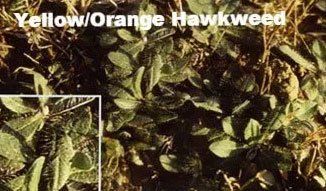
Yellow/Orange Hawkweed
This perennial species mostly grows in dry, infertile, acidic, and compacted soils. The flowers resemble dandelions and the rosettes include oblong, hairy leaves on the upper and lower surface. It spreads through seeds and short, leafy runners.
This perennial species mostly grows in dry, infertile, acidic, and compacted soils. The flowers resemble dandelions and the rosettes include oblong, hairy leaves on the upper and lower surface. It spreads through seeds and short, leafy runners.
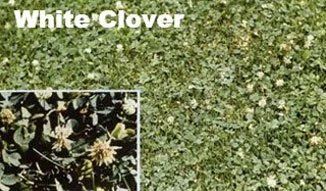
White Clover
It's a perennial legume found in nitrogen-deficit turfs and areas with excessive moisture over a long period of time. The leaves have three leaflets with white watermarks. It has creeping stems that root at the nodes. The flowers are white with a hint of pink, which attracts bees and other insects. The seeds can survive in soil for more than 20 years.
It's a perennial legume found in nitrogen-deficit turfs and areas with excessive moisture over a long period of time. The leaves have three leaflets with white watermarks. It has creeping stems that root at the nodes. The flowers are white with a hint of pink, which attracts bees and other insects. The seeds can survive in soil for more than 20 years.

Canada Thistle
A tough perennial reproduced by seeds and rhizomes, this weed is difficult to be controlled. Characterized by oblong leaves that are lobed with spiny, toothed margins, it's often single and scattered in a patch. The small, lavender to rose-purple flower heads grow in clusters on 1- to 5-foot-long stems.
A tough perennial reproduced by seeds and rhizomes, this weed is difficult to be controlled. Characterized by oblong leaves that are lobed with spiny, toothed margins, it's often single and scattered in a patch. The small, lavender to rose-purple flower heads grow in clusters on 1- to 5-foot-long stems.

Henbit
It's an upright winter annual member of the mint family with square stem branches near the ground. It germinates generally in the fall and flowers during the spring. Its leaves are deeply veined, hairy, coarsely toothed, and rounded. The upper leaves are stalkless and are clasped to the stem, covering bluish and pinkish flowers within them.
It's an upright winter annual member of the mint family with square stem branches near the ground. It germinates generally in the fall and flowers during the spring. Its leaves are deeply veined, hairy, coarsely toothed, and rounded. The upper leaves are stalkless and are clasped to the stem, covering bluish and pinkish flowers within them.
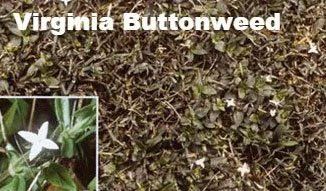
Virginia Buttonweed
A perennial kind, it's mostly found from New Jersey to Missouri and from the south to the Gulf Coast. It forms a rough vegetation mat from fuzzy, branching stems. It's characterized by smooth, dark-green, slender, elliptical leaves that are around 1 inch long. The leaves are arranged on opposite stems. It has fleshy roots with a woody crown. It blossoms with small, white flowers having delicate, white tufts of hair on the inner surface.
A perennial kind, it's mostly found from New Jersey to Missouri and from the south to the Gulf Coast. It forms a rough vegetation mat from fuzzy, branching stems. It's characterized by smooth, dark-green, slender, elliptical leaves that are around 1 inch long. The leaves are arranged on opposite stems. It has fleshy roots with a woody crown. It blossoms with small, white flowers having delicate, white tufts of hair on the inner surface.
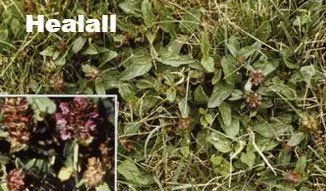
Healall
It's a low-growing perennial reproduced by seed or short runners, with sharply ridged square stems. The purple-colored leaves are elliptical with smooth margins and appear in pairs on each node. It has thick spikes of lipped, purple flowers.
It's a low-growing perennial reproduced by seed or short runners, with sharply ridged square stems. The purple-colored leaves are elliptical with smooth margins and appear in pairs on each node. It has thick spikes of lipped, purple flowers.

Ground Ivy
It's a perennial member of the mint family reproduced by seed and creeping stems, which roots at the nodes. It has square stems with a distinct mint odor and leaves with scalloped edges and rough upper surfaces. This weed forms dense patches in the sun or shade and is characterized by the spring blossom of trumpet-shaped, purplish flowers.
It's a perennial member of the mint family reproduced by seed and creeping stems, which roots at the nodes. It has square stems with a distinct mint odor and leaves with scalloped edges and rough upper surfaces. This weed forms dense patches in the sun or shade and is characterized by the spring blossom of trumpet-shaped, purplish flowers.

Parsley Piert
Found generally in the transition zone and the south, this is a winter annual species that grows on sandy soils. It's a seed reproduce.
Found generally in the transition zone and the south, this is a winter annual species that grows on sandy soils. It's a seed reproduce.
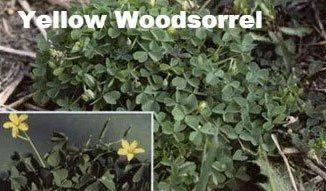
Yellow Woodsorrel
It's counted among annual and short-lived perennial spreads by seeds. If you touch this highly fertile weed, the pods will scatter the seeds for several feet.
It's counted among annual and short-lived perennial spreads by seeds. If you touch this highly fertile weed, the pods will scatter the seeds for several feet.
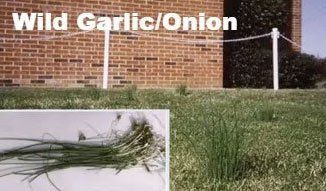
Wild Garlic/Onion
Reproduced perennially by bulb and bulblets, this bulb germinates during the spring or fall. The tops fade during the hot weather. The leaves are slender, hollow, smooth with a pink sheath at the base. You'll get a characteristic onion or garlic smell from the leaves. It bears pink, white, or green flowers.
Reproduced perennially by bulb and bulblets, this bulb germinates during the spring or fall. The tops fade during the hot weather. The leaves are slender, hollow, smooth with a pink sheath at the base. You'll get a characteristic onion or garlic smell from the leaves. It bears pink, white, or green flowers.


